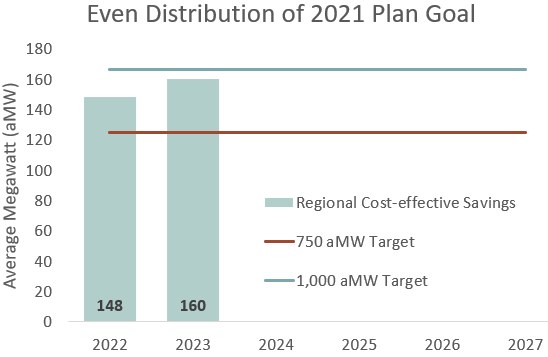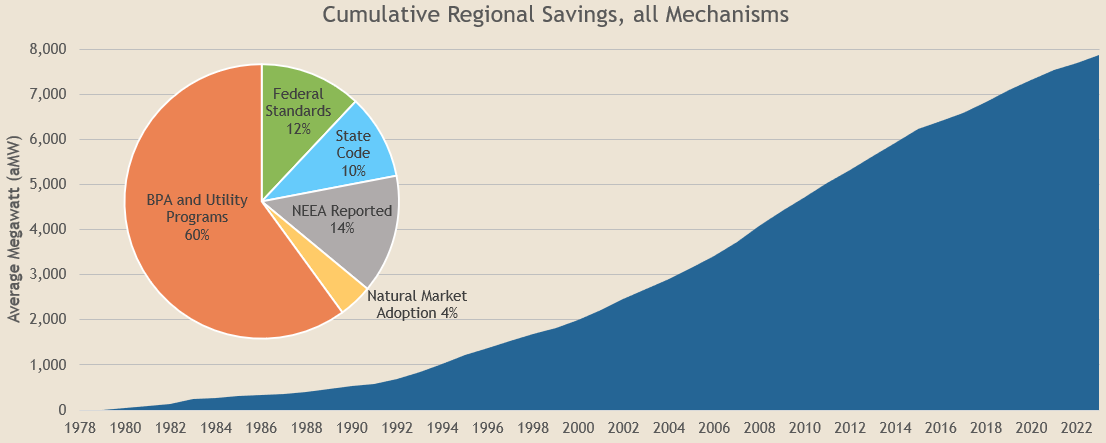Summary of Council’s Tracking of Conservation
In its charter the RTF is tasked with annually surveying the region’s utilities, Bonneville Power Administration, NEEA, and system benefit charge administrators like Energy Trust of Oregon on their efficiency achievements. The RTF supports the compiling of the data into a Regional Conservation Progress (RCP) report, and staff present it to the Council to offer a full picture of the region’s progress against the power plan’s efficiency goals. In the 2021 Power Plan, the Council set a conservation target range of 750-1,000 aMW within the six-year plan period. The 2023 RCP is the second year tracking to the 2021 Plan.
Expand the ⊕ navigation above for other years’ reports.
Cumulative Conservation Achievements and the 2021 Plan
2023 RCP Workbook Presentation Submitted to the Council
The Northwest as a region achieved 160 aMW of energy savings due to conservation measures. This total savings is representative of utility program savings, NEEA reported savings, and savings from codes and standards with an adjustment for double and under counting. The chart to the right illustrates how the regional savings compare to the Plan targets range using an even annual distribution of the goal and ramped version. As shown in the chart, the first two years of tracking puts the region on track to exceed the low end of the Council's 2021 Power Plan target range to ensure an adequate, efficient, economical, and reliable power supply.



Regional Savings by Sector
Savings from the commercial sector continued to represent half of the regional savings achieved in 2023, which was consistent with 2022. There was an increase in the amount of savings coming from the industrial sector in 2023, representing 26% of the savings. The residential sector saw a reduction in the amount of savings achieved, but still represented almost 20% of the savings in the region.
Although, residential savings represent less savings in the region than in past Plans, there continues to be energy efficiency opportunities for these customers. The region is offering residential customers comprehensive savings opportunities in all the major end uses for homes, including heating and cooling, lighting, water heating, and electronics.


Other Regional Savings Achieved
The 2021 Power Plan Conservation Program recommended that the region pursue efficiency beyond what is just cost-effective, to achieve other goals, such as decarbonization, additional support of rural markets, and weatherizing the remaining leaky homes in the Northwest. Consistent with 2022, only 8% of the savings reported to the RCP in 2023 were in support of other regional savings goals.
In pursuit of capturing the remaining leaky homes in the Northwest as recommended by the Plan, the region has achieved 3.1 aMW in savings from weatherization measures in 2022 and 2023. The Plan assumes the potential for these measures is 14 aMW for the first two years of the Plan period. This means there remains significant potential for weatherization measures in the region.
Historical Regional Savings
Energy efficiency has provided over 7,865 aMW of savings since 1978. It has helped the region avoid more than 25 million metric tons of C02 emissions and has saved the equivalent of 6.3 million homes’ annual energy consumption. The chart below shows that utility efficiency programs have been the key driver of energy savings in the region, with NEEA’s market transformation work emerging in recent years as a significant contributor of regional savings.


